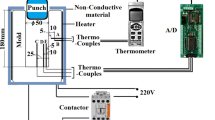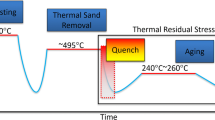Abstract
Aluminum alloy castings are normally water quenched after solution treatment to improve mechanical properties. Rapid water quenching can result in high-residual stress and severe distortion which significantly affect functionality and performance of the products. To optimize product design and durability, one needs to model and predict residual stress and distortion produced in the water-quenched components. In this article, a finite element-based approach was developed to simulate the transient heat transfer and residual stress development during water quenching. In this approach, an iterative zone-based heat transfer algorithm was coupled with material constitutive model called mechanical threshold stress (MTS). With the integrated models, a good agreement was achieved between the numerically predicted and the experimentally measured residual stresses in the aluminum alloy frame-shape casting. The integrated FEA-based heat transfer and residual stress models were also applied to a water-quenched cast aluminum cylinder head with a great success.


















Similar content being viewed by others

References
K. Li, B. Xiao, and Q. Wang, Residual Stresses in As-Quenched Aluminum Castings, SAE Int. J. Mater. Manuf., 2009, 1(1), p 725–731
P. Li, D.M. Maijer, and T.C. Lindley, Simulating the Residual Stress in an A356 Automotive Wheel and Its Impact on Fatigue Life, Metall. Mater. Trans. B, 2007, 38(4), p 505–515
A. Rose, O. Kessler, and F. Hoffmann, Quenching Distortion of Aluminum Castings-Improvement by Gas Cooling, Materialwiss. Werkst., 2006, 37(1), p 116–121
Y.L. Lee, J. Pan, and R. Hathaway, Fatigue Testing and Analysis: Theory and Practice, Elsevier Butterworth-Heinemann, Burlington, 2005, p 402
Z. Li, R.V. Grandhi, and R. Srinivasan, Distortion Minimization during Gas Quenching Process, J. Mater. Process. Technol., 2006, 172(2), p 249–257
G.E. Totten, C.E. Bates, and N.A. Clinton, Handbook of Quenchants and Quenching Technology, ASM International, Materials Park, OH, 1993, p 514
M. Sedighi and C.A. McMahon, The Influence of Quenchant Agitation on the Heat Transfer Coefficient and Residual Stress Development in the Quenching of Steels, Proc. Inst. Mech. Eng. B J. Eng. Manuf., 2000, 214(7), p 555–567
J.P. Holman, Heat Transfer, McGraw-Hill, New York, 2002, p 665
M. Maniruzzaman, J. Chaves, and C. McGee, CHTE Quench Probe System: A New Quenchant Characterization System, 5th International Conference on Frontiers of Design and Manufacturing (ICFDM), 2002, p 619–625
D.K. Funatani, M. Narazaki, and M. Tanaka, Comparisons of Probe Design and Cooling Curve Analysis Methods, 19th ASM Heat Treating Society Conference Proceedings Including Steel Heat Treating in the New Millennium, G. Krauss, S.J. Midea, and G.D. Pfaffmann, Ed., ASM International, Cincinnati, OH, 1999, p 255–263
M.L. Newman, B.J. Robinson, and H. Sehitoglu, Deformation, Residual Stress, and Constitutive Relations for Quenched W319 Aluminum, Metall. Mater. Trans. A, 2003, 34(7), p 1483–1491
H. Sehitoglu, T. Smith, and X. Qing, Stress-Strain Response of a Cast 319-T6 Aluminum Under Thermomechanical Loading, Metall. Mater. Trans. A, 2000, 31(1), p 139–151
C.M. Estey, S.L. Cockcroft, and D.M. Maijer, Constitutive Behaviour of A356 During the Quenching Operation, Mater. Sci. Eng. A, 2004, 383(2), p 245–251
J. Lu and M. James, Handbook of Measurement of Residual Stresses, Fairmont Press, Inc, Lilburn, GA, 1996, p 237
G.S. Schajer, Measurement of Non-Uniform Residual Stresses Using the Hole-Drilling Method. Part I-Stress Calculation Procedures, J. Eng. Mater. Technol., 1988, 110, p 338–343
ASTM Designation: E837-01, ASTM International, Philadelphia, PA, 2002, p 703–712
B. Xiao, Q. Wang, and P. Jadhav, An Experimental Study of Heat Transfer in Aluminum Castings During Water Quenching, J. Mater. Process. Technol., 2010, 210(4), p 2023–2028
Compaq Inc., Fortran, Version 6.6, TX, USA, 2002
ABAQUS Inc., ABAQUS Help Documentation, Version 6.7, Providence, RI, 2007
B. Xiao, K. Li, and Y. Rong, Automatic Determination and Experimental Evaluation of Residual Stress Calibration Coefficients for Hole-Drilling Strain Gage Integral Method, Strain, 2010, doi: 10.1111/j.1475-1305.2009.00650.x
B. Xiao, Q. Wang, G. Wang, R.D. Sisson, and Y. Rong, Robust Methodology for Determination of Heat Transfer Coefficient Distribution in Convection, Appl. Therm. Eng., 2010, 30(17), p 2815–2821
Acknowledgments
This work was supported financially by PowerTrain, General Motors Company, MI, USA. Dr. Bing Li from GM PowerTrain helped with meshing the cylinder head.
Author information
Authors and Affiliations
Corresponding author
Rights and permissions
About this article
Cite this article
Xiao, B., Li, K., Wang, Q. et al. Numerical Simulation and Experimental Validation of Residual Stresses in Water-Quenched Aluminum Alloy Castings. J. of Materi Eng and Perform 20, 1648–1657 (2011). https://doi.org/10.1007/s11665-011-9866-7
Received:
Revised:
Published:
Issue Date:
DOI: https://doi.org/10.1007/s11665-011-9866-7



